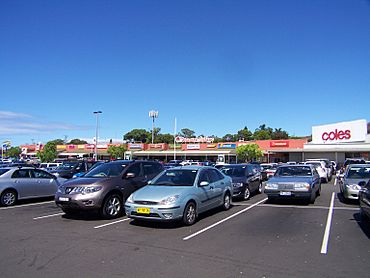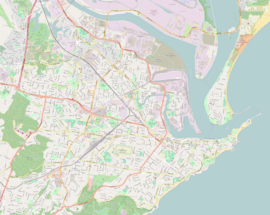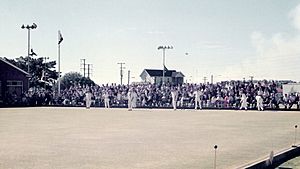Waratah, New South Wales facts for kids
Quick facts for kids WaratahNewcastle, New South Wales |
|||||||||||||||
|---|---|---|---|---|---|---|---|---|---|---|---|---|---|---|---|

Waratah Village Shopping Centre in March 2011
|
|||||||||||||||
| Established | 1871 | ||||||||||||||
| Postcode(s) | 2298 | ||||||||||||||
| Area | 1.9 km2 (0.7 sq mi) | ||||||||||||||
| Time zone | AEST (UTC+10) | ||||||||||||||
| • Summer (DST) | AEDT (UTC+11) | ||||||||||||||
| Location | 6 km (4 mi) WNW of Newcastle | ||||||||||||||
| LGA(s) | City of Newcastle | ||||||||||||||
| Region | Hunter | ||||||||||||||
| County | Northumberland | ||||||||||||||
| Parish | Newcastle | ||||||||||||||
| State electorate(s) |
|
||||||||||||||
| Federal Division(s) | Newcastle | ||||||||||||||
|
|||||||||||||||
Waratah is a suburb located in the north-west of Newcastle, New South Wales, Australia. It's about 6 kilometres (about 3.7 miles) from Newcastle's main city area. The Main North railway line forms its northern border. Waratah has its own train station, which opened in 1858. It is served by the NSW TrainLink's Hunter line.
Contents
Waratah's Past
The very first people to live on this land were the Awabakal people. They are part of a larger group called Awabagal/Gadjang, also known as Worimi. Experts believe the Awabakal territory covered about 1,800 square kilometres (about 695 square miles).
Waratah was once a very important town on its own. It became an official "municipality" in 1871. This meant it had its own elected council and a mayor to lead the town. Two mayors, John Scholey and N.B. Creer, were elected three times each. They both lived in North Waratah, which is now called Mayfield, New South Wales. John Scholey helped start the Waratah Bowling Club.
In the past, Waratah also had a large coal mine, or "colliery," which was a big part of its industry.
Today, Waratah is home to a major hospital called the Calvary Mater. It used to be known as the "Mater Misericordiae." The hospital is run by the Roman Catholic Sisters of Mercy. Nearby, there is also a large retirement and nursing home called Maroba, which has over 150 beds.
Rosary Convent
In 1888, a special building for nuns, called a "nunnery," was built in Waratah. It was started by the Dominican Sisters. This nunnery was used to teach children who were deaf. The first stone for the building was laid on a day called Rosary Sunday in 1888.
Over time, fewer women chose to become nuns. By 1989, there were only 180 nuns left in the order. The Dominican Sisters also started a smaller school called Corpus Christi. In 1987, the nuns handed over the leadership of this school to others.
School for Deaf Girls
In 1875, a deaf nun named Mary Gabriel Hogan came to Australia from Ireland. She was sent by the Dominican Nuns of Cabra to teach deaf children. The school was located on Alfred Street and helped students from 1886 to 1979. It was the only Catholic school in Australia and New Zealand that taught deaf children.
On December 8, 1875, Catherine Sullivan from Bathurst was the very first student to join. Between 1875 and 1888, 17 girls and 13 boys from all over Australia and New Zealand enrolled. In the 1920s, more than 200 girls and 100 boys attended the school.
In 1922, a new school for deaf boys, St Gabriel's School, was opened in Castle Hill. All the boys from Waratah moved to this new school. In the 1930s, the school's name changed from the "Institution of the Deaf and Dumb" to the "School for Deaf Girls." In 1938, Sister M Nobert O.P. started teaching students to speak instead of only using sign language.
On July 11, 1948, a fire broke out in the girls' sleeping area, and the school had to close. It reopened in 1951. The school was mentioned in a government report in 1979, and it closed soon after. After it closed, a new centre for children with hearing problems, called St Dominic's, opened in Mayfield.
Waratah House
A special piece of land was given to Charles Simpson because of his important work for the Port of Newcastle. Mr. Simpson cleared the land and started a farm there. The house was finished by 1848. He named the house "Waratah House" because of the many Waratah flowers growing in the area. This is also how the suburb of Waratah got its name!
People sometimes called the house "Simpson’s Folly." This was because it was so far from Newcastle, and Mr. Simpson used to travel there by boat. In 1848, Charles Simpson bought three more plots of land nearby.
After Mr. Simpson passed away in 1850, the property was sold to Major Charles Bolton. Major Bolton decided to divide the land into smaller pieces. In 1860, he sold it to Mr. Thomas Tourtle. Mr. Tourtle was a very rich "squatter," meaning he made a lot of money from his large land holdings. He lived in Waratah House until he died in 1899. Sadly, the house was torn down in 1993 so that a company called BHP could build a pipe mill.
Schools in Waratah
Waratah has several schools for different age groups:
- Callaghan College Waratah Technology Campus (for students in Years 7–10). This school used to be called Waratah High School, and before that, Newcastle Boys' High School.
- Waratah Public School (a state-run primary school).
- St. Philip's Christian College (a private school).
- Corpus Christi (a Roman Catholic primary school).
Local Places to See
Here are some important and interesting places in Waratah:
- Calvary Mater Hospital
- Maroba Nursing Home
- Corpus Christi Catholic Church
- Waratah Oval and Park (great for sports and outdoor activities)
- Mens Shed
- Hunter Prostate Cancer Alliance
- Waratah Police Station
- Newcastle Eye Hospital
- Tinonee Gardens aged care facility
- Braye Park
- Waratah has one main shopping centre called Waratah Village. It has a Coles supermarket and a Kmart store that is open 24 hours. You can also find a newsagent, a post office, and banks like Newcastle Permanent Building Society and Greater Building Society. The shopping centre is famous for its amazing Christmas lights display!
- Station Street is about 200 metres (about 656 feet) away and has two hotels: The Royal (also known as The Purple) and The Town Hall (also known as The Orange). There's also a doctor's office and some smaller shops. Some old shops and the former Waratahs Rugby Club have been turned into two childcare centres.



